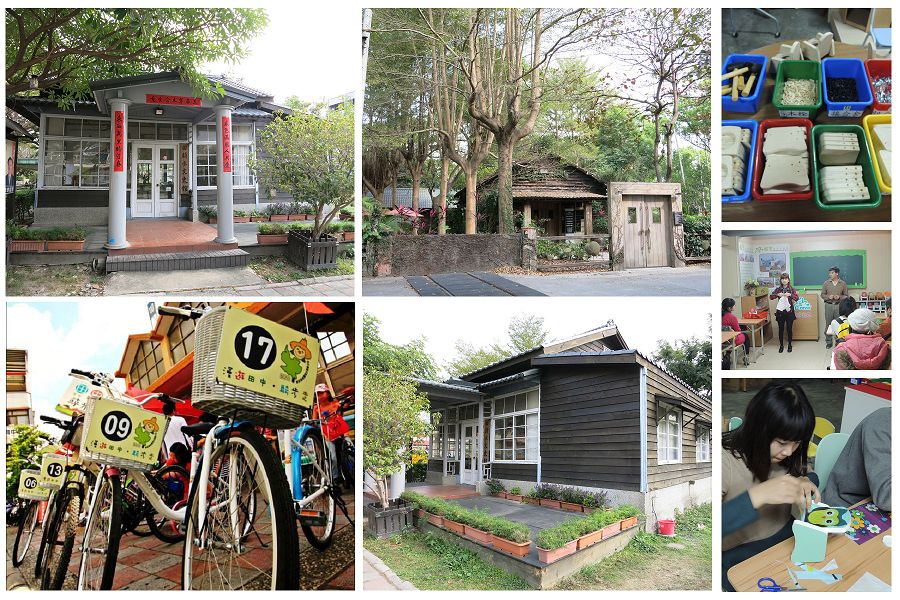

|
Downtown Wandering - the exploration to the downtown of Tianjhong |
|---|
|
The downtown area of Tianjhong mainly covers central, east, west, south, and north villages. It's said that Tianjhong was first originated at Yue-xing Street which is close to the bank of the old Zhuo-shui River. In the year of 1838, the street was destroyed by the flood, so the residents moved to Sha-lun Street. In the year of 1898, Sha-lun Street was again destroyed by the flood and fire. At the same time, the Japanese colonial government set up the train station in Tianjhong, so the residents moved again near the station.
After the train station was set up in 1905, the sugar refinery took Tianjhong as the transfer center for their trains. The convenience of transportation lead to the development of commercial business in Tianjhong. Along the Yuan-ji Road and Zhung-zhou Road appear numerous beautiful buildings. When you wander along these streets, you can appreciate the beauty of the architecture in various stages.
The train station which was set up in 1905 was refurbished several times. The most distinguishing feature of the building is its five-triangle roof. In January of 2013, the new train station was established, and the ticket office, the entrances, the waiting room, and other facilities are all set on the second floor. Besides, it also provides well-organized space for commercial business and all kinds of services. The old building was remained and re-organized as the Cultural Gallery of Tianjhong to promote the art and culture work. In addition to these two buildings, there is a square in front of the two stations. On the square retains the small train of the sugar refinery in the Japanese ruled period. After you walk out of the train station and turn left for three minutes, you can see antique cypress wood buildings established during the Japanese ruled period. The interior designer, Mr. Qiu-hong Dong leases a part of the place as his personal studio. He makes good use of his expertise to refurbish the long abandoned railways and the Agriculture Council of fertilizer distribution to make a notable restaurant, Stonefish Coffee. Now it attracts many tourists stop to linger for its vicissitudes and decadent style landscaping. Across from the Stonefish Coffee is the Fu-mao Furniture Store, which is mainly for children's wooden furniture business. Because of its high quality, their products are sold to all over the world. in recent years, they concurrently run the sightseeing wood factory which provides visitors to experience the fun of handmade DIY. Their creative products was popular with people, so on holidays it always attracts large numbers of foreign tourists to visit. Qian-de Temple located around the corner of Yuan-ji Road and Dou-zhung Road is mainly to worship the lady of sky from Meizhou. Here is the religious center for the local residents. In recent years, the followers went to Meizhou for the ancestral pilgrimage, and organized around the three-day return trip border activities. There are many wonderful troupes around the town, and every place where they pass by all the people prepare incense to warmly welcome their coming. This activity is worth visitors to come together for experiencing the vitality of folk beliefs. On the corner of Fu-xing Road and Nan-bei Street is a building "Shou Shan Hall" built by Mr. Shao-nian Chen and his offspring. The architecture style of the building is a mixture of Japanese and Southern Min, and it is currently classified as "proposed monument." Mr. Chen is an important figure in the westward migration of the residents, and he has a decisive influence on the development of neighborhoods in Tianjhong. His grandson, Jing Sung Chen, had ever been to Japan for studying medicals. After he returned from Japan, he ran the Jing Sung Hospital on Yuan-ji Road to aid to poor patients and won the respect of local residents. His son, Shi-ying Chen served as the magistrate of Changhua county for the benefit of the village. In order to memorize the spirit of Dr. Jung Sung Chen, the Changhua County Government names the park on Zhung-zhou Road "Jing Sung Memorial Park" to remember the gratitude of Dr. Chen. |
|
|


著作權所有 (c) 2015田中高中。保留所有權利。















